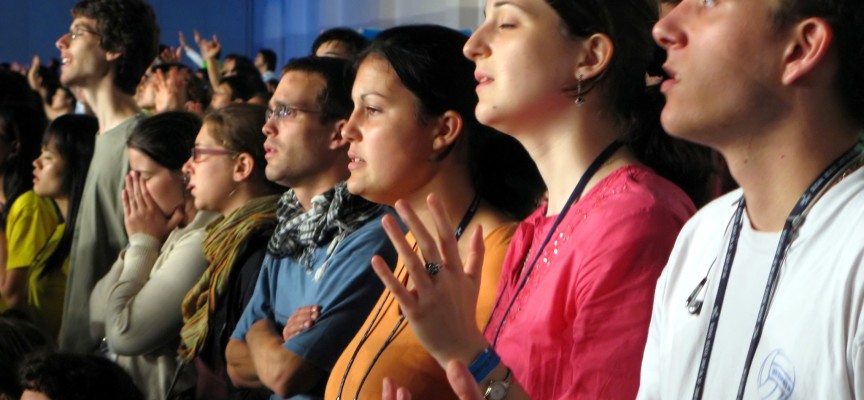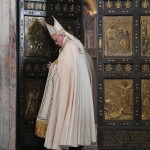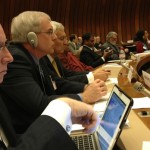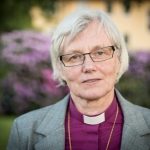By way of preface, attempts to quantify the number of ‘Protestants’ in Europe (and in the rest of the world) are always quite tricky. Firstly, we need to consider that the world that has originated from the Protestant Reformation of the 16th century encompasses both the ‘traditional’ denominations that have taken their name from their founders – Lutheran, Calvinist – as well as the many others that were born in the ensuing centuries, such as Baptist, Methodist and Mormon. Furthermore, Pentecostalism has recently become quite popular, in addition to a whole variety of other denominations that are inspired by a ‘freer’, ‘more evangelical’ brand of Protestantism that calls for a ’reawakening’. These latter denominations are actually gaining the upper hand in Latin America, drawing millions of faithful away from Catholicism. That being said, the figures you will find in this article refer to European Protestantism and, essentially, to Lutherans and Calvinists, as well as Anglicans in England. Over the last few years (and especially months) a number of Catholics (or people who call themselves such) have been vocal about the need for the Church of Rome to adjust to so-called international progress regarding major current anthropological issues, following the example provided by most of the Protestant world. The fact that most Northern European Lutherans (recently joined by Anglicans belonging to the Church of England) are in favor of recognizing so-called ‘same sex marriages’ is well known; and this applies also to the possibility of ordaining women priests and bishops and several ‘new rights’ related to life’s beginning and end. They have also peacefully accepted the teaching of gender ideology in schools. However, has this adjustment or passive acceptance to the ‘demands’ of unbridled secularization been beneficial to European Protestantism’s vitality? In order to reply, we will refer to figures mostly coming from national Protestant Churches’ own statistical data. Let us start with Germany: Luther’s homeland. In 1990, after reunification, Protestants were 29.4 million (36.9% of the overall population); in 2004, they were down to 26.2 million (31. 5%) and, in 2013, 23.3 million (29%). In 1990, Catholics were 28.5 million (35.4%), dropping to 24. 2 million (30%) in 2013. Between 2004 and 2013, Protestant christenings have gone from 236 thousand to 187 thousand; confirmations from 272 thousand to 227 thousand; marriages from 59 thousand to 49 thousand. During the same time, Sunday worship attendance has declined from 4 to 3.5%. . Let us now move to Switzerland: the country of Zwingli, Calvin and Forel (who started the Protestant Reformation in Zurich, Geneva and Neuchatel respectively). In 1970, Protestants used to be 48.8 % of the overall population, outnumbering Catholics by about two percentage points. In 2000, they had dropped to 33.9% and 26.0% in 2013. The number of Catholics also declined – but to a lesser, albeit worrisome, extent – from 46.7% in 1970, to 42.3% in 2000 and 38.2% in 2013. It is also worth noting that Protestants no longer rank first neither in Zurich nor in Basel, Lausanne or Neuchatel, and have fallen behind Catholics and/or nonbelievers. One more statistical fact: in 2012, more people in Switzerland left the Protestant faith compared to Catholicism (as was the case in Germany); a situation that applies to the whole Confederation, with the exception of the diocese of Coira (which includes Zurich), where conflicting trends are reported for Catholics. The Netherlands are a particularly significant case: in 1971, Protestants used to be 35.9% of the overall population; in 2010, their number had fallen to 15.6% (Catholics have gone from to 40.4 to 24.5%). When the three main Protestant denominations decided to merge in 2004 (Orthodox Calvinists, Reformed Calvinists and Lutherans), their flock included more than 2,400,000 sheep. Now there are less than 1,800,000 left. It is worth noting that the Netherlands have been the first nation in the world to recognize so-called ‘same sex marriages’; and they are also infamously pioneering in end-of-life matters, together with Belgium, a former Catholic country. Let us now turn to Scandinavia, where other progressive groups support so-called ‘new rights’. Like the Netherlands (a Calvinist country), Denmark, Sweden, Norway, and Finland have traditionally been Protestant countries (mostly Lutheran). Formally, these are all countries where Protestantism is deeply rooted and still very popular, at around 80%. However, recent population surveys have revealed that, in Sweden, nonbelievers are now 45% and, in Norway, 33%. Back in 2008/2009, the Swedish and Norwegian Parliaments recognized so-called ‘same sex marriages’; Denmark followed suit in 2012 and Finland, (the most ‘conservative’ Scandinavian country) did so in the last few months. Actually, when the Finnish Parliament decided to recognize such ‘marriages’ on Nov. 28th of last year, with 102 votes in favor and 95 against, this caused a major rift inside the Lutheran world, whose leaders expressed their satisfaction with Parliament’s decision. In a matter of days, more than 13 thousand Protestants abandoned their ecclesial community, without considering the fact that the official endorsement of Parliament’s decision by Lutheran leaders has made the ecumenical dialogue with Catholics and Orthodox a lot more complicated. What about Anglicans? Let us start from hard figures. In Great Britain, in 1983 Anglicans accounted for 40% of the British population; in 2012, they had become 20% (Catholics had gone from 10 to 9%). Let us remember what happened some years ago: in 1993, women could be ordained priests; in 2006, the ordination of women bishops was declared to be theologically justified. As a reaction to this, three bishops and about fifty Anglican priests, as well as hundreds of faithful, asked to join the Catholic Church, and this actually happened in 2011. In July 2014, the Synod of the Church of England officially gave the green light to the ordination of women bishops (this decision was confirmed by both Houses of the British Parliament). For years now, the Anglican Church has been talking about the ordination of homosexual priests and bishops, as well as the possibility to bless same sex couples. In January 2013, the ordination of homosexual priests officially became a possibility. In a speech held the following July in York, Justin Welby – the Anglican Archbishop of Canterbury – highlighted that it would be “absurd and impossible” to ignore changes happening in society; therefore, we should “open up to homosexuals”. This does not necessarily mean supporting so-called “same sex marriages” (Archbishop Welby has always expressed his disagreement on this); however, specific “anti-homophobia” programs would have to become mandatory in five thousand Catholic schools in the UK. In November 2013, the Church of England gave permission to celebrate same sex marriages in the church. In the meantime, church attendance on Sunday has dropped from 1.2 million faithful to 800 thousand in the last twenty years, below the number of Catholics who go to Mass on a regular basis. After having read all these figures we cannot but asks ourselves whether we should really follow the currently prevailing ideological-economic relativism – as many Protestant ecclesial communities have done – distorting our identity in order to win back the faithful we have lost. Beyond any other kind of reasoning, we believe that figures are quite eloquent and unmistakably so. Premessa: quando si cerca di quantificare il numero dei ‘protestanti’ in Europa (e anche nel resto del mondo), si presentano subito difficoltà non minime, derivate prima di tutto dal fatto che nel mondo originato dalla Riforma protestante del XVI secolo si muovono – oltre alle ‘sigle’ storiche connotate dal nome del loro fondatore (luterani, calvinisti) – le tante altre denominazioni nate in secoli successivi, come ad esempio i battisti, i metodisti, i mormoni. Non solo: più recente è il diffondersi dei pentecostali e di tutta una miriade di sigle che si rifanno a un protestantesimo ‘libero’, ‘evangelico’, ‘di risveglio’. Sono del resto queste ultime che stanno dilagando in America latina, strappando milioni di fedeli al cattolicesimo. Ciò detto, i numeri che troverete nel prosieguo dell’articolo e che riguardano il protestantesimo europeo, sono riferiti sostanzialmente a luterani e calvinisti, con l’aggiunta – per l’Inghilterra – degli anglicani. Negli ultimi anni (e negli ultimi mesi in particolare) si sono levate dall’area cattolica (o che tale si definisce) voci che – in riferimento soprattutto ai grandi temi antropologici dell’attualità – auspicano che la Chiesa di Roma si adegui al cosiddetto progresso internazionale in materia proprio come ha fatto buona parte del mondo protestante. È noto che la maggioranza dei luterani dell’Europa settentrionale (raggiunti negli ultimi mesi anche dagli anglicani della Chiesa d’Inghilterra) si è schierata in favore del riconoscimento dei cosiddetti “matrimoni omosessuali”. Del sacerdozio ed episcopato femminile. Dell’ordinazione di sacerdoti e vescovi omosessuali. Di tanti tra i ‘nuovi diritti’ in materia d’inizio e fine vita. Ha subito senza fiatare l’imposizione dell’ideologia del gender nelle scuole. Ma tale adeguarsi, tale piegarsi alle ‘esigenze’ della secolarizzazione più spinta ha forse comportato effetti positivi sulla vitalità del protestantesimo europeo? Per rispondere ci serviamo dei numeri, attingendo ai dati statistici forniti in larga parte dalle stesse Chiese nazionali protestanti. Incominciamo dalla Germania, patria di Lutero. Dopo la riunificazione, nel 1990, i protestanti erano 29,4 milioni (il 36,9%) della popolazione; nel 2004 erano scesi a 26,2 milioni (31,5%) e nel 2013 a 23,3 milioni (29%). Nel 1990 i cattolici erano 28,5 milioni (35,4%), nel 2013 24,2 milioni (30%). Dal 2004 al 2013 i battesimi protestanti sono passati da 236mila a 187mila, le confermazioni (cresime) da 272mila a 227mila, i matrimoni da 59mila a 49mila. Nello stesso lasso di tempo la partecipazione al culto domenicale è scesa dal 4 al 3,5%. Veniamo alla Svizzera di Zwingli, Calvino e Forel (artefici della Riforma rispettivamente a Zurigo, Ginevra e Neuchatel). Nel 1970 i protestanti erano il 48,8% della popolazione e superavano di un paio di punti i cattolici. Nel 2000 erano scesi al 33,9%, nel 2013 al 26,9%. Calo anche per i cattolici – ma in percentuale minore, pur se preoccupante –, passati dal 46,7% del 1970 al 42,3% nel 2000, al 38,2% del 2013. È anche interessante notare che ormai i protestanti non sono più al primo posto né a Zurigo né a Ginevra né a Basilea né a Losanna né a Neuchatel, sorpassati dai cattolici e/o dai non credenti. Altra constatazione statistica: nel 2012 il protestantesimo in Svizzera ha registrato più abbandoni del cattolicesimo (come del resto in Germania): un dato che si ritrova in tutta la Confederazione, ad eccezione del territorio corrispondente alla diocesi di Coira (che comprende Zurigo), dove la situazione in campo cattolico è assai conflittuale. Un caso molto significativo è quello dell’Olanda: lì i protestanti, che nel 1971 erano il 35,9% della popolazione, nel 2010 erano scesi al 15,6% (i cattolici dal 40,4 al 24,5%). Quando nel 2004 le tre principali denominazioni protestanti si unirono (calvinisti ortodossi, calvinisti moderati, luterani), il gregge comprendeva oltre 2.400.000 pecorelle. Oggi ne restano meno di 1.800.000. Da notare che l’Olanda è stata la prima nazione al mondo a riconoscere i cosiddetti “matrimoni gay”, ed è tristemente pure alla cosiddetta avanguardia in materia di fine vita, insieme con il Belgio, Paese ex-cattolico. Andiamo adesso in Scandinavia. Lì troviamo altri avanguardisti in materia dei cosiddetti “nuovi diritti”. Come l’Olanda (però calvinista) anche Danimarca, Svezia, Norvegia, Finlandia sono storicamente Paesi protestanti (perlopiù luterani). Formalmente sono tutti Paesi in cui il protestantesimo è ben radicato, con maggioranze ancora massicce, oltre l’80%. Tuttavia da inchieste demoscopiche recenti si scopre poi che in Svezia i non credenti raggiungono il 45% e in Norvegia il 33%. In Svezia e Norvegia già nel 2008/2009 il Parlamento ha riconosciuto i cosiddetti ‘matrimoni gay’, in Danimarca nel 2012, in Finlandia (il Paese scandinavo più ‘conservatore’) in questi mesi. E proprio in Finlandia la decisione parlamentare di riconoscere tali “matrimoni”, presa lo scorso 28 novembre con 102 voti contro 95, ha provocato una forte spaccatura all’interno del mondo luterano, il cui responsabile si è felicitato per il risultato. In pochi giorni oltre 13mila protestanti hanno abbandonato la loro comunità ecclesiale, senza contare che l’appoggio ufficiale del vertice luterano alla decisione ha complicato di molto il dialogo ecumenico con cattolici e ortodossi. E gli anglicani? Partiamo dai numeri, crudi. In Gran Bretagna nel 1983 gli anglicani rappresentavano il 40% della popolazione britannica, nel 2012 il 20% (cattolici dal 10% al 9%). Piccolo ripasso di storia: nel 1993 viene introdotto il sacerdozio femminile, nel 2006 si decide che l’episcopato femminile è teologicamente giustificato. Come reazione, 3 vescovi e una cinquantina di sacerdoti anglicani, oltre a centinaia di fedeli, chiedono di aderire alla Chiesa cattolica, il che si concretizza nel 2011. È del luglio 2014 il ‘sì’ definitivo alle donne-vescovo da parte del Sinodo della Chiesa d’Inghilterra (confermato dai due rami del Parlamento britannico). Da anni poi nella Chiesa anglicana si discute dell’ordinazione di preti e vescovi omosessuali e della benedizione di coppie dello stesso sesso. Nel gennaio 2013 si annuncia la disponibilità a consacrare vescovi anche preti omosessuali. In un discorso del luglio seguente a York l’arcivescovo anglicano di Canterbury, Justin Welby, evidenzia poi che “sarebbe assurdo e impossibile” ignorare i cambiamenti nella società. Perciò “bisogna aprirsi agli omosessuali”. Ciò non significa automaticamente essere favorevoli ai cosiddetti “matrimoni gay” (Welby si è sempre dichiarato piuttosto contrario) e tuttavia è doveroso che anche nelle cinquemila scuole cattoliche del Regno s’introducano programmi “contro l’omofobia”. Nel novembre 2013 la Chiesa d’Inghilterra permette la benedizione di coppie omosessuali in chiesa. Intanto la partecipazione al culto domenicale è scesa negli ultimi vent’anni da 1,2 milioni di fedeli a 800 mila, meno dei cattolici che abitualmente assistono alla santa messa. Dalla lettura delle cifre che abbiamo dato sorge prepotente una domanda: è proprio il caso di assecondare – come hanno fatto molte comunità ecclesiali del mondo protestante – il relativismo imperante di tipo ideologico-economico, snaturando la propria identità nel tentativo di recuperare i fedeli smarriti? Al di là di ogni altra considerazione ci sembra che le cifre parlino. Inequivocabilmente
Giuseppe Rusconi
Latest posts by Giuseppe Rusconi (see all)
- Where is traditional european protestantism heading? - 22 gennaio 2015











